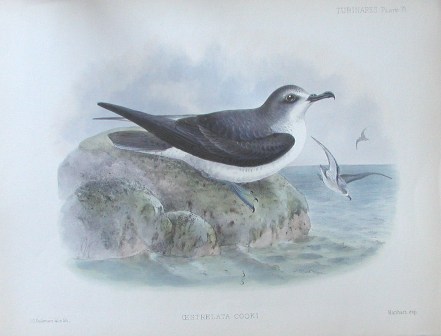|
| 질의: birds of america | 결과: 462번째/1888 | |
Cook's Petrel (Pterodroma cookii) - Wiki
| 제목: | Cook's Petrel (Pterodroma cookii) - Wiki
| |

| 해상도: 441x336
파일크기: 26339 Bytes
촬영일: 0000:00:00 00:00:00
사진기: C4040Z (OLYMPUS OPTICAL CO.,LTD)
F number: f/1.8
Exposure: 10/500 sec
Focal Length: 73/10
등록시간: 2007:12:11 15:07:37
|
Cook's Petrel
From Wikipedia, the free encyclopedia
Order: Procellariiformes
Family: Procellariidae
Synonyms: Oestralata cooki
[Photo] Cook's Petrel (Pterodroma cookii). Source: Godman, Frederick du Cane, Monograph of the Petrels, 1907???1910. URL: www.nzbirds.com/birds/cookspetrel.html
Cook's Petrel (Pterodroma cookii) is a species of seabird and a member of the gadfly petrels. The bird is 25-30 cm in size, with a 65-66 cm wingspan.
This species is highly pelagic, rarely approaching land, except to nest and rear young. It ranges in the Pacific Ocean from New Zealand north to the Aleutian Islands. It sometimes can be seen well off the west coast of the United States and well off the west coast of tropical South America. Cook's Petrel feeds on mostly fish and squid, with some crustaceans taken. This bird breeds on offshore islands near New Zealand.
Cook's Petrel uses burrows and rock crevices to nest in. It prefers thickly forested ridges. It was formerly more numerous than today. Numbers were affected by predation by introduced mammals and Wekas. Populations have started to recover as rats and cats and other introduced wildlife are removed from breeding islands.
http://en.wikipedia.org/wiki/Cook's_Petrel
| The text in this page is based on the copyrighted Wikipedia article shown in above URL. It is used under the GNU Free Documentation License. You may redistribute it, verbatim or modified, providing that you comply with the terms of the GFDL. |
|
^o^
동물그림창고 똑똑전화 누리집
^o^
|
|

